127.29 Stormwater
127.29.1 Introduction
Stormwater runoff has the potential to transfer pollutants to drainage courses and waterbodies causing damaging effects to water quality and aquatic ecosystems. MoDOT’s stormwater discharges are authorized by a Transportation Separate Storm Sewer System (TS4) Permit issued by the Missouri Department of Natural Resources (MDNR). The following guidance outlines MoDOT’s stormwater management program in accordance with the Clean Water Act, National Pollution Discharge Elimination Program (NPDES) and Missouri’s’ Clean Water Law.
127.29.2 Definitions
Best Management Practice (BMP) – From MDNR’s 10 CSR20-6.200: Schedules of activities, prohibitions of practices, maintenance procedures, and other management practices to prevent or reduce the pollution of waters of the state. BMPs also include treatment requirements, operating procedures and practices to control plant site runoff, spillage or leaks, sludge or waste disposal, or drainage from raw material storage.
Boundary Point Source – a point source that is not an outfall. The location where the point source leaves MoDOT right of way.
Illegal connection - a pipe or other conveyance that has illegally been connected to MoDOT’s TS4.
Illicit discharge - is defined by MDNR's 10 CSR 20-6.200 as a discharge of pollutants to a Municipal Separate Storm Sewer System (MS4) that is not comprised entirely of stormwater and is not authorized under the NPDES permit.
Major stormwater outfall – MDNR defines as “a municipal separate storm sewer outfall that discharges from a single pipe with an inside diameter of thirty-six inches (36") or more (or its equivalent)”. Reference: 10 CSR 20-6.
MoDOT Community – MoDOT staff and external partners including contractor’s and consultants.
MoDOT’s TS4 area – MoDOT property including but not limited to roadway right-of-way, maintenance and storage yards, fleet or maintenance shops, with outdoor storage areas, salt/sand storage locations, snow disposal areas, parking lots, welcome centers, rest areas, and other areas owned and operated by MoDOT located within urbanized areas as defined by latest Decennial Census by the Bureau of Census and regulated municipal separate storm sewer systems not located in Urbanized areas per 10 CSR 20-6.200 (5)(C) 24.B.
MS4 – Municipal Separate Storm Sewer System.
Municipal separate storm sewer - a conveyance or system of conveyances including roads and highways with drainage systems, municipal streets, catch basins, curbs, gutters, ditches, paved or unpaved channels, or storm drains designated and utilized for routing of stormwater which:
- A. Does not include any waters of the state as defined in this rule;
- B. Is contained within the municipal corporate limits or is owned and operated by the state, city, town, village, county, district, association, or other public body created by or pursuant to the laws of Missouri having jurisdiction over disposal of sewage, industrial waste, stormwater, or other liquid wastes;
- C. Is not a part or portion of a combined sewer system;
- D. Is not a part of a publicly owned treatment works as defined in 40 CFR 122.2; and
- E. Sewers that are defined as large or medium or small municipal separate storm sewer systems pursuant to paragraphs 10., 15., and 28. of this section, or designated under subsection (1)(B) of this rule.
New development – MoDOT defines new development for purposes of the MS4 permit, to mean projects (with land disturbance greater than or equal to 1 acre) that are constructed where there was previously no transportation facility.
Nonpoint source pollution – a type of pollution that occurs when water runs over land or through the ground, picks up pollutants, and deposits them in surface waters or introduces them into groundwater.
Non-structural practices/controls - operational BMPs that prevent or reduce pollutants from entering stormwater. Examples include preventative maintenance procedures, minimizing impervious surfaces, and spill prevention and cleanup.
Permanent BMP – a best management practice designed to be permanently left in place after construction to treat or contain stormwater.
Point source discharge – any discernible, confined and discrete conveyance, including but not limited to any pipe, ditch, channel, tunnel, conduit, well, discrete fissure, container, rolling stock, concentrated animal feeding operation, or vessel or other floating craft, from which pollutants are or may be discharged. Point source does not include agricultural stormwater discharges and return flows from irrigated agriculture.
Pollutant - Dredged spoil, solid waste, incinerator residue, sewage, garbage, sewer sludge, munitions, chemical waste, biological materials, radioactive materials, heat, wrecked or discarded equipment, rock, sand, cellar dirt, filter backwash or industrial, municipal or agricultural waste discharged into water. Reference: Reference: 10 CSR 20-2.
Redevelopment - MoDOT defines redevelopment for purposes of the TS4 permit with respect to transportation facilities, to mean non-maintenance work performed to or on an existing public transportation facility which provides for an increased number of thru lanes of travel unless the work can be accommodated without increasing the width of the existing pavement. Widening of an existing road that does not result in an additional thru lane does not constitute redevelopment. Widening to add shoulders does not constitute a thru lane unless the total widening is greater than or equal to 10 feet.
Run-on – stormwater from adjacent landowners or development that is combined with MoDOT’s stormwater.
Stormwater outfall – a point source where intentionally collected stormwater exits the right of way (ROW) and enters a “water of the state”. For example, roadside ditch.
(Stormwater) Outfall – MoDOT defines an outfall as intentionally collected stormwater that is “A point source as defined by 10 CSR 20-2.010 at the point where a municipal separate storm sewer discharges and does not include open conveyances connecting two (2) municipal separate storm sewers, pipes, tunnels, or other conveyances which connect segments of waters of the state and are used to convey waters of the state.” Reference: 10 CSR 20-6.
Structural practices/controls - physical, structural or mechanical devices or facilities intended to prevent pollutants from entering stormwater. Examples include building berms around potential pollutant source areas, roofs over outside truck wash bays, etc.
Thru lane - a lane of a roadway intended to facilitate moving vehicles along a corridor.
TMDL Total Maximum Daily Load - a mathematical calculation of the amount of a specific pollutant a waterbody can absorb and still meet water quality standards.
waters of the state – MDNR defines as “all rivers, streams, lakes and other bodies of surface and subsurface water lying within or forming a part of the boundaries of the state which are not entirely confined and located completely upon lands owned, leased or otherwise controlled by a single person or by two or more persons jointly or as tenants in common and includes waters of the United States lying within the state.” Reference: Missouri Revised Statutes 644.016.
Acronyms and Abbreviations
| BMP | Best Management Practice |
| CWA | Clean Water Act |
| EPA | Environmental Protection Agency |
| EPG | Engineering Policy Guide |
| ESC | Erosion and Sediment Control |
| FHWA | Federal Highway Administration |
| GI | Green Infrastructure |
| IDDE | Illicit Discharge Detection and Elimination |
| LID | Low Impact Development |
| MCM | Minimum Control Measure |
| MEP | Maximum Extent Practicable |
| MDNR | Missouri Department of Natural Resources |
| MoDOT | Missouri Department of Transportation |
| MS4 | Municipal Separate Storm Sewer System |
| MSD | Metropolitan Sewer District – St. Louis |
| NPDES | National Pollutant Discharge Elimination System |
| O&M | Operation and Maintenance |
| ROW | Right of way |
| SOP | Standard Operating Procedure |
| SPCC | Spill Prevention Control and Countermeasure |
| SWMP | Storm Water Management Plan |
| SWPPP | Storm Water Pollution Prevention Plan |
| TMDL | Total Maximum Daily Load |
| TS4 | Transportation Separate Storm Sewer System |
| UA | Urbanized Area as defined by US Census |
127.29.3 Purpose
EPG 127.29.3 Purpose outlines obligations of the statewide stormwater permit which requires MoDOT to develop, implement, and enforce a comprehensive stormwater management program to reduce the discharge of pollutants to the maximum extent practical (MEP)stormwater. The following guidance is intended to assist MoDOT staff and consultants with understanding MoDOT’s stormwater management program and the six individual minimum control measures that make up that plan.
Provisions of the Federal Clean Water Act and related state rules and regulations require a municipal separate storm sewer system (MS4) permit when the facility serves a population of 50,000 or more within an urbanized area or are located outside an urbanized area serving a jurisdiction with a population of at least 10,000 and a population density of 1,000 people per square mile or more. Furthermore, a municipal separate storm sewer means a conveyance or system of conveyances including roads and highways with drainage systems, municipal streets, catch basins, curbs, gutters, ditches, paved or unpaved channels, or storm drains designated and utilized for routing of stormwater. MoDOT’s TS4 permit is an individual permit drafted to fill this obligation to better fit the operations of a transportation organization.
127.29.4 Stormwater Management Program
The major requirement of the permit is to develop, implement, and enforce a Stormwater Management Program. The obligation of the permit is for the Stormwater Management Program to be developed to achieve compliance with the standard to reduce the discharge of pollutants to the maximum extent practicable per 40 CFR 122.34.
As part of the Storm Water Management Program, MoDOT is obligated to develop a Storm Water Management Plan (SWMP) explaining the Storm Water Management Program by identifying, tracking, and evaluating programmatic BMPs for each of the six minimum control measures (MCM) included it the permit. BMPs have been developed or designed with the purpose of reducing stormwater pollution. The plan must also list the person primarily responsible for the plan and the person(s) responsible for each MCM if different from the primary person.
127.29.4.1 MCM 1: MoDOT Community & Public Education and Outreach on Stormwater Impacts Program
Permit requirement. The permittee shall implement a community education program that focuses on the impacts of stormwater discharges on water bodies and steps that MoDOT Community and the general public can take to reduce pollutants in stormwater runoff. The Education and Outreach on Stormwater Impacts Program shall contain, at a minimum, the following:
- 1. Maintain the MoDOT stormwater webpage with stormwater related topics;
- 2. Participate in education and outreach events to promote water quality;
- 3. Maintain public outreach programs such as No More Trash Bash, adopt a highway, and sponsor a highway programs;
- 4. Distribute stormwater brochures;
- 5. Maintain public awareness campaigns. This may be through the MoDOT website, social media, or other media outlets.
As part of our program for MCM 1: MoDOT Community and Public Education and Outreach on Stormwater Impacts, MoDOT has developed BMPs that educate the MoDOT community as well as the general public. BMPs target education efforts regarding stormwater impacts and the steps MoDOT takes to reduce pollutants in stormwater runoff. MoDOT operates and maintains a web page located on the world wide web that reaches an untold number of audiences by providing a 24/7, 365 days a year platform to educate and receive customer concerns regarding stormwater.
A dedicated email address is used to provide a consistently available, portable, cost effective way to communicate with the public.
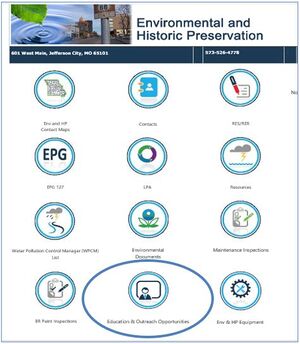
MoDOT develops and distributes a stormwater brochure to provide a tangible item that can be read and reviewed by the community and public at their convenience.
MoDOT engages in many training efforts to educate the MoDOT community as well as the general public regarding stormwater impacts. One general public education effort is tied to the No MOre Trash Bash, a department program to educate the public on the effects of litter. Other outreach efforts occur at Earth Day and the State Fair. These platforms provide an opportunity to reach a large audience with practices they can do to improve water quality through their daily actions.
At times, MoDOT conducts education opportunities with local community high schools, colleges, and universities. Any events conducted by districts, that include stormwater as a topic, can be documented on Environmental and Historic Preservation’s SharePoint page. These events will be documented and included in the TS4 annual report.
MoDOT engages in public awareness campaigns utilizing social media outlets and internally produced publications to promote programs like the No MOre Trash Bash and litter campaigns.
127.29.4.2 MCM 2: MoDOT Community and Public Involvement/Participation Program
Permit requirement: The permittee shall implement a public involvement/participation program that provides opportunities for both public and MoDOT community involvement in the development and oversight of the permittee’s stormwater management program, and provides opportunities for both the public and MoDOT community involvement of the permittee’s renewal application. The public involvement/participation program shall, at a minimum, include the following:
- 1. A public notice period to allow the public and MoDOT community the opportunity to review the SWMP and renewal application prior to submission of the SWMP and renewal application to the Department. It is recommended that the public review period is at least 10 (ten) business days;
- 2. If the permittee utilizes a stormwater management panel/committee, then the permittee shall provide opportunities for input for public and MoDOT Community on the panel/committee;
- 3. Maintain the MoDOT Stormwater email;
- 4. Maintain a web “Report a Stormwater Concern” for visitors to submit stormwater concerns;
- 5. Track and report how many spill control and counter measure reports (SPCC) came from internal personnel or other methods;
- 6. Coordinate with other MS4 communities when appropriate.
MoDOT uses various tools and techniques to engage public involvement and participation. These tools and techniques are implemented on statewide and local jurisdictional levels through the department’s community relations office located in Central Office, as well as the department’s seven district offices at the local level.
In accordance with the permit MoDOT utilizes a Public Notice (PN) period to allow for comments to alterations to publications such as the SWMP, permit renewals, etc. An e-updates tool was developed to allow interested people to sign up for notifications regarding MoDOT’s stormwater program. Public notice periods for SWMP and renewal applications will be a minimum of 10 days and will be posted on MoDOT’s Stormwater webpage in addition to being emailed statewide with an opportunity for public hearing (see EPG 129.13 Public Involvement for Stormwater). This specifically applies to the SWMP and renewal application which is submitted to MDNR every 5 years upon permit expiration.
MoDOT also engages the assistance of the public in reporting stormwater concerns by offering an on-line Stormwater Concern Form. This tool promotes engagement with the public and allows MoDOT to evaluate more areas when issues exist.
Internally, the MoDOT community uses a dedicated email group that disseminates information from field staff to subject matter experts that can evaluate a potential pollution situation and determine appropriate steps to protect critical environmental elements. Spillreporting@.mo.gov is a critical tool to get information out quickly, assisting MoDOT in being responsive to those conditions where pollution potentials exist. Externally, MoDOT offers a Stormwater@modot.mo.gov email address for stormwater concerns to be relayed to the department.
MoDOT’s TS4 area includes all urbanized areas and regulated MS4 communities not located in urbanized areas. MoDOT is obligated to follow the requirements of the TS4 permit but should coordinate when appropriate with the other MS4 communities. MoDOT has representatives who participate on other MS4 panels/committees. The project development process also offers a unique opportunity to collaborate with adjacent MS4 communities to foster environmental stewardship and coordinate on common goals.
127.29.4.3 MCM 3: Illicit Discharge Detection and Elimination (IDDE) Program
Permit Obligation: The permittee shall implement, and enforce a program to detect and eliminate illicit discharges into the TS4. Vehicular accidents are not considered illicit discharges unless the spill enters waters of the state. The IDDE program shall include, at a minimum, the following:
- 1. A stormwater outfall database, with mapping capabilities documenting the location of all known outfalls and the names and location of all receiving waters of the state that receive discharges from the TS4. The permittee shall make the map data and its origin available to the Department and EPA upon request
- 2. Detect, investigate, and eliminate illicit discharges into the TS4 and implement appropriate procedures or actions to the extent allowed by MoDOT’s authority.
- 3. To the extent allowable under state or local law, effectively prohibit through regulatory mechanism or equivalent, non-stormwater discharges from illicit discharges into the TS4 and implement appropriate procedures or actions.
- 4. MoDOT shall maintain a plan and schedule to detect and address non-stormwater discharges, including discharges from illegal dumping and spills, to the TS4. The Missouri Department of Health and Senior Services (DHSS) shall be contacted when wastewater discharge from a private homeowner is found on the MoDOT right of way.
- 5. MoDNR shall be contacted when wastewater discharge from a commercial entity is discovered on a MoDOT right of way.
- 6. MoDOT will communicate with MoDNR for possible enforcement actions necessary concerning any business or industry that does not have a valid permit from MoDNR to discharge effluent to the highway right of way.
- 7. Report immediately the occurrence of any dry weather flows believed to be an immediate threat to human health or the environment to MoDNR by calling the Environmental Emergency Response 24-hour Environmental Emergency Response Spill Line at 573-634-2436.
- 8. Inform the MoDOT community and the general public of hazards associated with illegal discharges and improper disposal of waste.
- 9. Maintain methods of public reporting of the presence of illicit discharges or water quality impacts associated with stormwater discharges are possible by contacting any of MoDOT’s seven Customer Service Centers, Central Office, or MoDOT’s website including the Report a Stormwater Concern form. Tracking shall be maintained in conjunction with MCM 1.
- 10. Maintain the Adopt-A-Highway program, for volunteer groups to periodically pick up the trash and debris along the sides of state highways. Tracking shall be maintained in conjunction with MCM 1.
- 11. MoDOT shall educate and cross-train maintenance staff to assist with identification of illicit discharges on MoDOT right of way.
- 12. The permittee shall address the categories of non-stormwater discharges or flows listed under Section I Part A – COVERAGE AND RESTRICTIONS, item 2 (a – q) if the permittee identifies them as significant contributors of pollutants to the TS4.
The definition of an illicit discharge is, any discharge to an MS4 (or TS4) that is not composed entirely of stormwater, except allowable discharges pursuant to an NPDES permit. Illicit discharges are considered “Illicit” because MS4s are not designed to accept, process, or discharge such non-stormwater wastes. Common sources of illicit discharges include sanitary wastewater, effluent from septic tanks, sediment from construction sites, car wash wastewaters, improper petroleum product disposal, laundry wastewaters, improper disposal of automobile, and household toxics, yard waste, pet waste, and illicit connections to drainage structures. For additional information see EPG 127.25.3.1 Rest Area Lagoon, EPG 127.25.8.3 Sewage Disposal System, and EPG 127.25.8.3.2 System Attachments by Others.
When illicit discharges are discovered in the right-of-way, the Environmental Section of Design should be notified. An Environmental Specialist will investigate the discharge and contact DNR and request their assistance to impose whatever legal action necessary concerning any business or industry that does not have a valid permit from MDNR to discharge effluent to the highway right of way. When illicit discharges are discovered coming from residential properties, the local Department of Health office in the county in which the discharge exists will be contacted. Discharges discovered by the general public can be reported through the “Report a Stormwater Concern” electronic form out on MoDOT’s external web site. Links to the form can be found on the main page and the Stormwater Page.
MoDOT encourages the general public to assist with efforts of illicit discharge detection and elimination. An electronic “Report a Stormwater Concern” form is accessible from MoDOT’s external web home page as well as from the stormwater webpage. MoDOT also maintains an illicit discharge detection and elimination web page where visitors can learn how to report a stormwater concern as well as review MoDOT’s illicit discharge pamphlet and find county health department contacts per district.
MoDOT maintains an inventory of outfalls as an obligation of the permit. This data is stored in TMS. Outfalls can be viewed under the stormwater layer on the TMS map or on the Illicit Discharge Detection and Elimination page located on MoDOT’s external website. When projects are designed that will modify or create new outfalls, the district shall furnish a spreadsheet of outfalls by location and type in the project area with the final request for environmental services (RES). The spreadsheet shall contain, for each outfall, the location of the outfall in latitude/longitude, the name of the nearest road, the name of the stream to which the outfall drains, and the type of outfall structure (e.g. pipe, inlet, ditch, or other).
MoDOT is authorized to discharge the following non-stormwater sources provided that the permitting authority has not determined these sources to be substantial contributors of pollutants to the permittee’s MS4 that require a separate permit:
- Landscape irrigation
- Rising ground waters
- Uncontaminated ground water infiltration
- Uncontaminated pumped ground water
- Discharges from potable water sources
- Foundation drains
- Air conditioning condensation
- Springs
- Water from crawl space pumps
- Footing drains
- Lawn watering
- Flows from riparian habitats and wetlands
- Street wash water
- Bridge wash water
- Discharges or flows from emergency firefighting activities
- Individual residential car washing
- Dechlorinated residential swimming pool discharges.
127.29.4.4 MCM 4: Construction Site Stormwater Runoff Control
This measure covers our existing policy in EPG 806 Pollution, Erosion and Sediment Control Program.
Additionally, this measure is also covered within EPG 173 Erosion Control for Maintenance Operations.
Permit Obligation: The permittee shall develop, implement, and enforce a program to reduce pollutants in any stormwater runoff to their TS4 from construction activities on areas owned by MoDOT that result in a land disturbance of greater than or equal to one acre. Reduction of stormwater discharges from construction activities disturbing less than one acre must be included in the program if that construction activity is part of a larger common plan of development or sale that would disturb one acre or more. The program shall include, at minimum, the following:
- 1. Department policies to require erosion and sediment controls are designed, implemented, and maintained for construction sites, as well as sanctions to ensure compliance, to the extent allowable under state or local law.
- 2. Maintain requirements for construction site operators to control waste such as discarded building materials, concrete truck washout, chemicals, litter, and sanitary waste at the construction site that may cause adverse impacts to water quality.
- 3. Procedures for plan reviews which incorporate considerations of potential water quality impacts to the receiving waterbody.
- 4. Continue training of MoDOT personnel and contractors through Land Disturbance Training to ensure compliance with the MoDOT Land Disturbance Program.
- 5. Erosion control inspections shall be required for all projects engaged in land disturbance of one acre or more.
- 6. Perform statewide audits of construction sites to ensure that the MoDOT Land Disturbance program and applicable SWPPP are being followed. In addition to site inspections conducted weekly and following significant rainfall events, MoDOT will conduct quality assurance audits of projects covered by the Land Disturbance program.
- 7. Maintain procedures for receipt and considerations of information related to stormwater runoff controls submitted by the MoDOT community or general public.
- 8. Procedures for site-inspections and enforcement of control measures.
- 9. MoDOT’s inspectors, Resident Engineers, designers, and contractor’s Water Pollution Control Managers shall receive land disturbance training at least once every four years.
MoDOT has a comprehensive land disturbance program authorized by Section II. Area Wide Land Disturbance Stormwater Permit Conditions of individual permit MO0137910. Though the land disturbance permit is covered under the same permit number as MoDOT’s TS4 permit, Section II. Is effectively is a stand-alone permit “STACKED” with the TS4 permit conditions.
MoDOT utilizes the Stormwater Database, an all-inclusive platform to track, document, and store land disturbance inspections for land disturbance projects. The database tracks inspection intervals, certification requirements, and deficiency observations as well as corrections. Through the deficiency correction process, the database documents when corrective actions are completed and calculates a $2,000 per day liquidated damage for failure to correct deficiencies within the time required by the permit.
EPG 806.8 Stormwater Pollution Prevention Plan (SWPPP) outlines MoDOT’s statewide approach to permit compliance to protect waters of the state. Procedures for plan reviews, inspection protocols, pollution prevention obligations, and procedures for consideration of stormwater information related by others are located in the SWPPP.
127.29.4.5 MCM 5: Post-Construction Stormwater Management in New Development and Redevelopment
Permit Obligation: The permittee shall develop, implement, and enforce a program to address the quality of stormwater runoff from new development and redevelopment projects on areas owned and operated by MoDOT that disturb greater than or equal to one acre, including projects less than one acre that are part of a larger common plan of development or sale that discharge to the TS4. The program shall include, at a minimum, the following information:
- 1. Strategies to minimize water quality impacts, which includes a combination of structural and/or non-structural BMPs appropriate for the TS4, including but not limited to the assessment of site characteristics at the beginning of the construction site design phase to ensure adequate planning for stormwater program compliance. The goal of this approach is to arrive at designs that protect sensitive areas, minimize the creation of stormwater pollution, and utilize BMPs that effectively remove stormwater pollution.
- 2. Policies and procedures to address post-construction runoff from new development and redevelopment projects to the extent allowable under state or local law;
- 3. Policies or procedures to ensure adequate long-term operating and maintenance of the BMPs;
- 4. Coordinate and partner with other MS4 communities. The MoDOT system impacts almost every regulated MS4 in the state. Promote good stewardship through coordination and cooperation with other regulated MS4s; and
- 5. Train design staff in the post construction BMPs program at minimum once every other year.
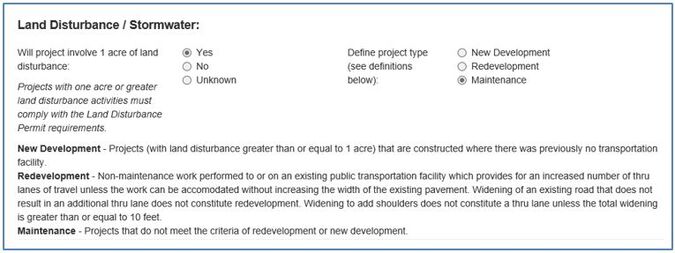
MoDOT will employ strategies that will comply with obligations of this MCM by reasonably mimicking pre-construction runoff conditions on all affected new development projects, through methods more appropriate for its community.
MoDOT utilizes its request for environmental services (RES) system to document project elements necessary to determine the obligation to consider post-construction BMPs on the project. It is the intent of the RES to get district staff to think about post construction BMPs earlier in the project development process by including elements of the decision-making process in the RES for the districts to determine at all phases of project development. Districts indicate if the project will involve land disturbance of one acre or greater as well as if they determine the project to be new development, redevelopment, or maintenance.
Central Office staff evaluates the project and the district’s determination of the project type. If they agree with the project type determination, the project’s location is evaluated to see if it falls inside the TS4 area. If the project is one acre or greater, considered new development or redevelopment, and falls within the TS4 area, the project must consider incorporating post construction BMPs into the project. Post-construction BMPs can be either structural or non-structural practices and controls.
Structural vs Non-structural Practices and Controls
Non-structural practices/controls are institutional, educational, or pollution prevention practices designed to limit the amount of stormwater runoff or pollutants. Examples of non-structural practices/controls are planning procedures, training programs, or site-specific BMPs such as riparian zone preservation, minimization of disturbed areas and reduced impervious areas, and maximization of open space.
Structural BMPs are physical controls working individually or as a group (treatment train) appropriate to the source, location, and area climate for the pollutant to be controlled. Structural BMPs fall into three categories or three main types of treatment BMPs – retention/detention, infiltration, and vegetative. These three types are not mutually exclusive, but one BMP may fit into more than one type.
Retention/Detention BMPs: These types of BMPs collect runoff and release it at a controlled rate to reduce impacts to downstream areas. Basins are a cost effective way to protect the local area from flooding and stormwater assist with water quality by settling out particulates from runoff. Examples include dry detention basins, wet detention basins, biodetention, stormwater wetland, wet ponds, etc.
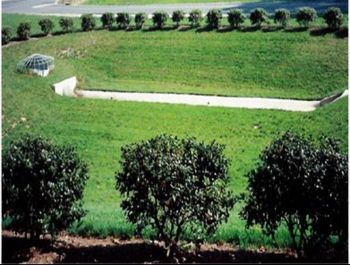
Infiltration BMPs: These types of BMPs collect runoff and promote infiltration which improves the water quality by removing pollutants through the natural filtering effects of the soil while recharging, lakes, streams, and groundwater. Stormwater examples include infiltration trenches/ditches/basins, grassy swales, pervious pavement, and infiltration basins or trenches.
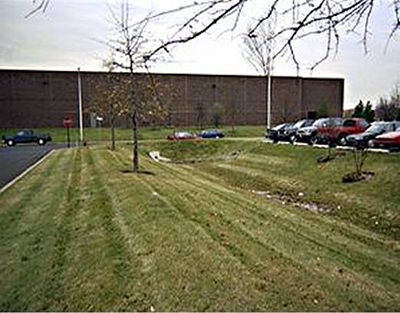
Vegetative BMPs: These types of BMPs incorporate dense vegetation or specific plant species to treat stormwater. Vegetation slows stormwater volumes allowing suspended solids to drop out as well as promoting filtering, adsorption, evapotranspiration, and biological uptake. Examples include grassy swales, filter strips, rain gardens, and wetlands.

| Potential Stormwater Controls | ||
|---|---|---|
| BMP | Definition | Function |
| Filtration Basin | A shallow basin with engineered media or soil and an underdrain. | Filtration, sorption, biological uptake, microbially mediated transportations. |
| Retention Basin | A wet basin that permanently holds water and limits discharges to large storm events. | Storage, detention, sedimentation |
| Bioretention Basin | A type of filtration basin with engineered media, an underdrain and landscaped vegetation. | Filtration, sorption, biological uptake, microbially mediated transportations. |
| Dry Detention Basin | A dry basin that temporarily holds water and slowly releases it over time. | Detention, sedimentation, sorption. |
| Rain Garden | A planted shallow depression that collects rainwater run-off from roof, parking lots and other surfaces. While a rain garden can blend into the landscape and serve as a garden area, its main function is to retain and treat collected stormwater. | Detention, filtration, sorption |
| Filter Strip | A linear section of land, either grassed or forested that physically infiltrates stormwater. | Filtration, infiltration, sorption, microbially mediated transformation, biological uptake. |
| Swale | A broad and shallow U-shaped channel with dense vegetation. | Filtration, infiltration, sedimentation, microbially mediated transformation, biological uptake. |
| Infiltration Basin | A shallow basin in permeable soils that detains and infiltrates stormwater runoff. | Infiltration, sorption. |
| Level Spreader | A trough and level lip used to redistribute concentrated stormwater as diffuse flow and sometimes combined with a filter strip. | Energy dissipation, infiltration. |
| Wet Detention Basin | A shallow basin that maintains a permanent pool of water using a control structure. | Detention, sedimentation, biological uptake, microbially mediated transformations. |
| Preformed Scour Hole | A riprap lined basin formed at the outlet of a pipe. | Energy dissipation, infiltration. |
| Forebay | A small basin located upstream of another stormwater control. | Detention, sedimentation. |
| Storm Water Wetland | Lands on which water is present either at or near the surface of the soil permanently or seasonally and supports wetland vegetation such as cattails. | Detention, sedimentation, sorption, biological uptake, microbially mediated transformations. |
| Proprietary Structure | Structure/system that a company or person owns rights to. | Various |
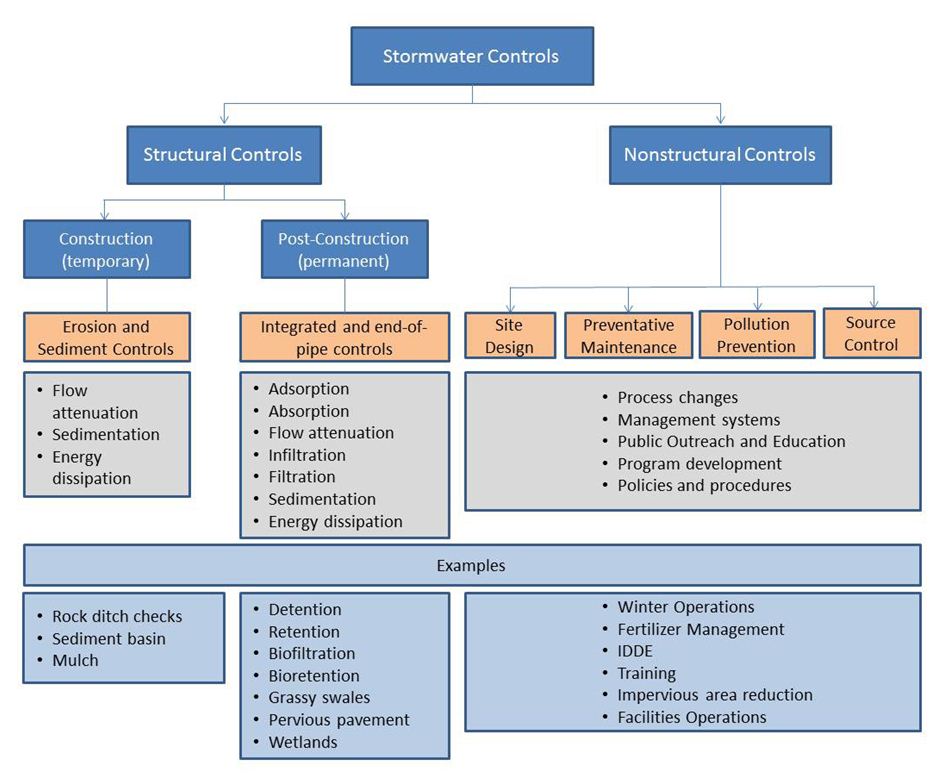
DNR provides a field guide, Protecting Water Quality: A Field Guide to Erosion, Sediment and Stormwater Best Management Practices for Development Sites in Missouri and Kansas, that is beneficial in outlining installation and maintenance of BMPs for permanent stormwater runoff management.
MoDOT has developed maintenance standard operating procedures for commonly used BMPs, below.
| Maintenance Standard Operating Procedures | |
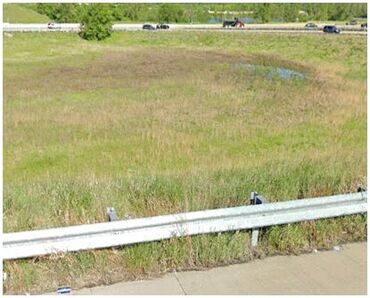 |
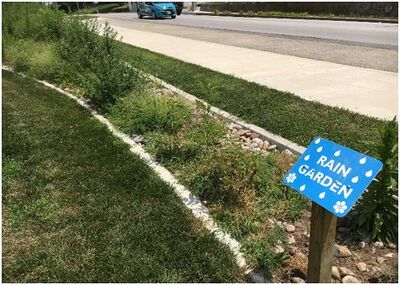 |
 |
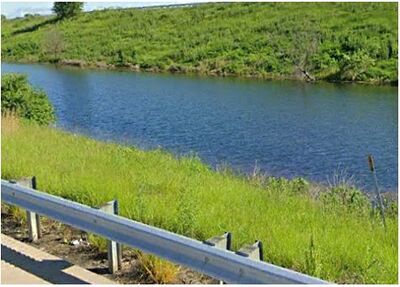 |
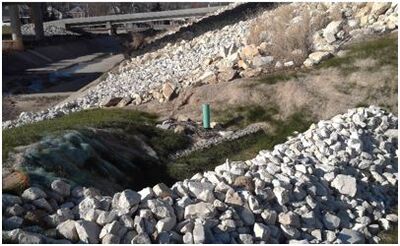 | |
Examples of redevelopment projects include adding a thru-lane, widening a bridge by a lane width, or widening shoulders where the shoulder width is 10 Ft. or more of additional width, etc.
Examples of new development projects include a new interchange on existing facility, adding an outer road where none existed previously, new facility where none existed previously, etc.
Examples of maintenance projects include ramp widening or extending (less than a lane width), signal installation, intersection improvements, retrofitting an existing interchange (for example, typical to a DDI), slide repair, adding shoulders that is less than a lane width, guardrail replacement, resurfacing, and overlay projects.
If a project meets the criteria for development or redevelopment, permanent post construction BMPs must be considered that treat the new impervious runoff in redevelopment and mimic the pre-existing runoff condition in new development. The district designer shall work with the environmental specialist to consider site constraints and identify opportunities for implementation. If part of a project is determined to be “new development” the entire project is captured under those requirements. General design philosophy will seek to mimic natural hydrology through dispersal and infiltration of runoff.
The district designer shall determine new runoff storage for redevelopment and pre-existing runoff in new development. Treatment BMPs are engineered stormwater treatment facilities and shall be designated on all phases of plan sheets. Many of these measures will capture and hold water and potentially develop wetland characteristics over time. If these are designated as stormwater treatment facilities, they will not be under the US Army Corps of Engineers jurisdiction as wetlands. Conversely, stormwater BMPs should not be sited within an existing jurisdictional wetland or its natural vegetated buffer except by permit or as part of a wetland mitigation plan. Wetlands may be considered for runoff treatment by passive means of dispersal.
In areas where the drainage is not captured via curb and gutter, open-bottom, grassy ditches may serve as permanent BMPs. Any consideration of grassy ditches as BMPs will require exact location of the BMP for documentation and future identification for inspection. Plans should clearly indicate the limits of these BMPs. Grassy swales are defined as a flat-bottomed or U-shaped ditch. If a flat-bottomed or U-shaped ditch cannot be achieved due to other site constraints, ditch blocks/checks can be used in conjunction with V-shaped ditches to achieve infiltration and absorption goals. Additionally, grassy medians that capture drainage are also included as a post-construction BMP but not tracked and inspected.

Example List of Commonly Used Post-Construction Control Practices:
- Infiltration basins
- Detention/retention
- Vegetated strips and/or swales
- Biofilters
- Permanent erosion control, seeding and planting
- Outlet protection/velocity dissipation devices
- Earth dikes, drainage swales and lined ditches
- Bridge slope protection
- Rock slope protection
- Mulching
- Verification that interior drains are not connected to a storm sewer system
Special Watersheds with TMDLs in Effect where MoDOT has been assigned a Waste Load Allocation (WLA)
In project areas where a total maximum daily load (TMDL) is in effect, it is feasible to tailor a permanent BMP to the pollutant identified. The American Association of State Highway Transportation Organization’s (AASHTO) Drainage Manual 2014 provides a table (Table 7-2) with the “Effectiveness and Applicability of Management Measures” for various permanent BMP control measures’ ability to remove specific pollutant types such as particulates, heavy metals, pesticides and organics. An example in table shows that curb elimination (promoting sheet flows) is highly effective at removing particulates, heavy metals and organics.
Currently, four watersheds located in the SL District are subject to an approved and effective TMDL where MoDOT has been assigned a WLA. They are Coldwater Creek, Watkins Creek, Creve Coeur Creek and Fishpot Creek. When a new development or redevelopment project with disturbances one acre or greater is planned within any of these watersheds, MoDOT will consider strategies appropriate to minimize water quality impacts. The pollutant of concern in these 4 watersheds obligates more value be given to media filters, bioretention, and/or retention practices as BMPs.
By the “final” RES stage submittal, the location of the permanent BMP(s) shall be included on the plan sheets. The plan sheets shall be supplied under the Land Disturbance/Stormwater section of the RES, for entry into the BMP database.
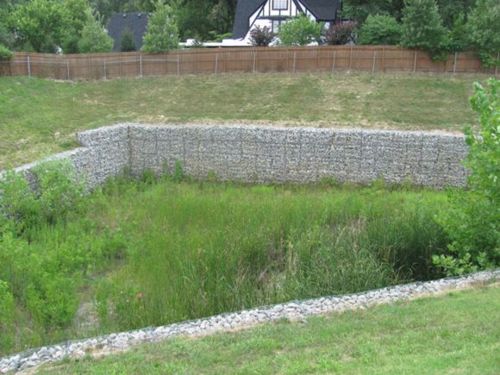
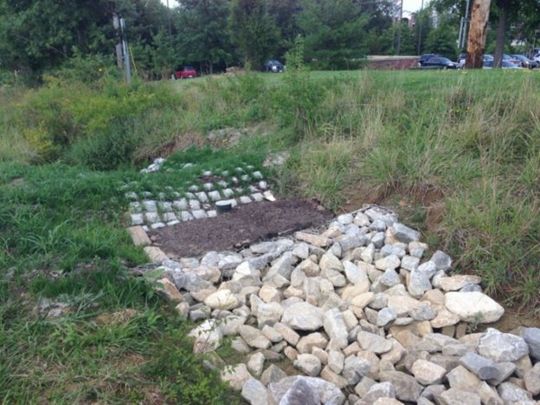
General Exemptions
Once a project has met the qualifying criteria of new development or redevelopment, post construction BMPs must be considered during the project delivery process. If it is not feasible to place permanent post construction BMPs in the project area due to constraints such as utilities, right-of-way, safety, environmental or cost, written justification must be documented in the project file. While permanent BMPs may not be feasible, the projects must still adhere, at a minimum, to MCM 4 Construction Site Runoff Control and MCM 6 Pollution Prevention and Good Housekeeping measures. Below are some general exemptions:
- Projects where the only work involved is the addition or rehabilitation of paved surfaces not intended for use by motor vehicles (such as sidewalks or bicycle/pedestrian trails).
- Removing and replacing a concrete or asphalt roadway to base course, or subgrade or lower, without expanding the impervious surfaces.
- Permit projects where MoDOT is not building/letting and the project is not on MoDOT right of way.
Coordination with Adjacent MS4 Community
During the scoping phase of the project delivery process, if a project is located within another MS4 regulated area, it is recommended the community be contacted by district staff or environmental staff to determine whether the community has post construction requirements under their permit program. Another option is to investigate the community’s website or other resource to determine if they have specific requirements. A general review of the MS4 community’s MCM 5 Post Construction Runoff Control requirements shall be conducted. The district shall use all pertinent BMP information to determine the preferred treatment BMPs or other BMP opportunities in the watershed. Since MoDOT is regulated by MDNR under a MS4 permit, MoDOT is not required to comply with another MS4 regulated community’s requirements. However, the district should make an effort to coordinate with the community in an effort to collaborate and share responsibilities.
If the MS4 community can provide a stormwater treatment option off MoDOT right-of-way, it is most beneficial to pursue that opportunity. Working with MS4 communities to partner for long-term management and maintenance is preferred.
Projects that are Located Partially Inside an MS4 Community
If a MoDOT project is partially within the TS4 coverage area, but partially outside of the TS4 coverage area, permanent BMPs shall only be considered within the TS4 coverage area. The entire project description shall be used to determine the type of project, redevelopment or development, and therefore type of treatment.
If it is not feasible to include permanent BMPs in the project and there are opportunities within the portion of the project outside the TS4 area, a swap is acceptable.
Cost-Share Projects and Unique Funding Projects
For cost-share projects within the TS4 area, permanent BMPs shall be applied using the flow chart to areas on MoDOT right of way that is applicable.
If it is not feasible and there are opportunities within the adjacent MS4 community, a swap is acceptable. An agreement for long-term maintenance must be agreed to by both entities.
If funding is through the community or county and MoDOT is only providing engineering services, post-construction BMPs are not required to be considered by MoDOT based on the TS4 permit, but may be required by the community or county's MS4 stormwater permit.
Cost-Share projects that are entirely specific to a design element, such as railroad grade separations, sidewalks, etc. may be exempt if no other work is involved in that MS4 project area.
Projects as a Result of Adjacent Development
If a project is a result of an adjacent development and would not have otherwise been constructed by MoDOT, the water quality and/or quantity features shall be included in that development.
Traffic permits
If adjacent developments require an access permit and are within the TS4 coverage area, runoff from adjacent development must be treated prior to entering MoDOT right of way or directed away from MoDOT right of way.
Adjacent developments that drains to MoDOT right of way cannot increase flows from the pre-construction condition.
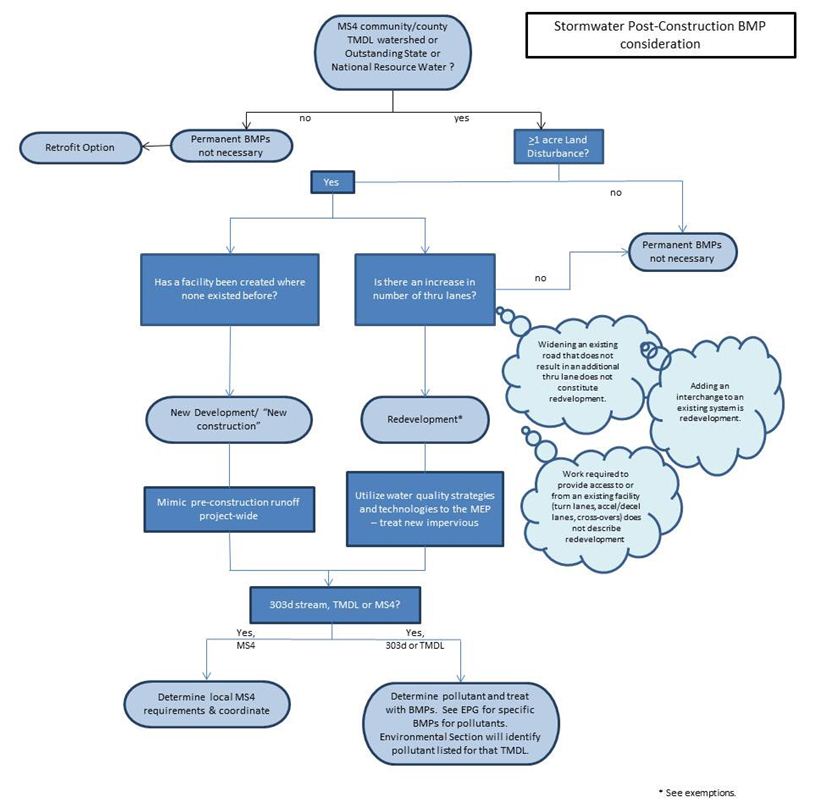
127.29.4.6 MCM 6: Pollution Prevention/Good Housekeeping
Permit Obligation: The permittee shall develop and implement an operation and maintenance program with the goal of preventing or reducing pollutant runoff from MoDOT operations and maintenance located in areas established in Part A – COVERAGE AND RESTRICTIONS, item 1.
As part of the SWMP, the pollution prevention/good housekeeping program shall include:
- 1. A list of all MoDOT operations and maintenance areas subject to this program.
- 2. BMPs designed or developed with the purpose of reducing floatables or other pollutants into the TS4 or waters of the state.
- 3. MoDOT shall maintain good housekeeping and material management procedures and BMPs for the storage and disposal of materials that pose a potential to pollute stormwater at MoDOT maintenance or fleet facilities. Such materials include, but is not limited to, antifreeze, batteries, fuel, equipment cleaning fluids, paint, herbicides, and used oil.
- 4. Inspections of MoDOT-owned operations and maintenance facilities within the TS4 coverage area shall be conducted at minimum bi-annually (every six months). These inspections shall identify potential target pollutants and sources, and take action for managing those sources. Issues identified during an inspection should be addressed or resolved before the next rain event and no later than the next inspection.
- 5. MoDOT shall maintain procedures to prevent, contain, and respond to spills.
- 6. Maintain MoDOT community training on BMPs to prevent or reduce stormwater pollution. Track how many MoDOT staff, and non-MoDOT staff when applicable, were educated on each topic, at minimum every other year. Behavioral changes and responses to situations shall be used to determine if the training is sufficient.
The intent of MCM 6, pollution prevention/good housekeeping is the evaluation of a permit holder’s operations at their facilities and subsequent alteration of actions at those locations that help to ensure a reduction of pollution that may occur from stormwater runoff.
The success of this program hinges on BMP implementation and maintenance. BMPs can be structural or procedural. Procedural BMPs such as parking fleet vehicles away from drain inlets or weekly parking lot sweeping promote pollution prevention without evasive measures that take significant resources to develop and maintain.
Structural BMPs such as berms, swales and basins are critical protective elements of a facilities plan to protect receiving waters from pollutants stored at a site. Each facility within MoDOT’s TS4 area must have a Facility Runoff Control Plan (FRCP). These plans outline good housekeeping and pollution prevention best management practices to reduce or eliminate pollutant laden runoff from MoDOT’s maintenance and operations facilities. The plans outline target pollutant education, inspection obligations, and corrective action guidance for those facilities and operations within the TS4 area.
FRCP inspections are required to be completed once every six (6) months. Inspections must be completed by a qualified facility inspector. Qualifications are outlined in the FRCP plan. Inspection forms and corrective measure documentation forms are included in the FRCP plan and are to be maintained for a period of three (3) years at the facility or electronically as determined by district maintenance management. FRCP plans, inspections, and corrective actions identified during inspections must be accessible and made available to regulating agency personnel upon request.
See 10 CSR 20-6.200.
MoDOT’s Coverage Area

References:
EPA guidance on minimum control measures, National Menu of Stormwater BMPs.
EPA SWMM model for stormwater BMPs.
AASHTO, 2014, AASHTO Drainage Manual, 1st Edition, American Association of State Highway and Transportation Officials.
127.29.5 Public Involvement for Stormwater
A public notice will be posted on MoDOT’s stormwater page and emailed to stakeholders when MoDOT is submitting a renewal application to the MDNR or other pertinent stormwater documents, for example, SWMP or annual reports, for a period of not less than 10 days prior to submittal.
A public hearing may be requested during the public notice period for MoDOT’s TS4 Site-specific State Operating Permit. The request must give reasonable cause for holding the hearing. A public hearing will be held if there is significant technical merit and concern related to the responsibilities of MoDOT. At least 30 days prior to the hearing MoDOT will post public notice of the hearing. The hearing will be held in the geographic area appropriate to the request.